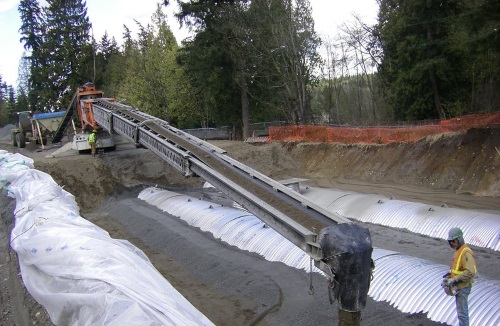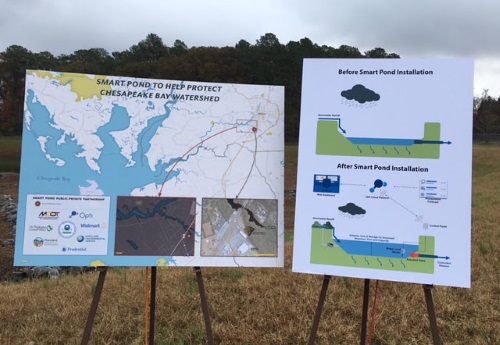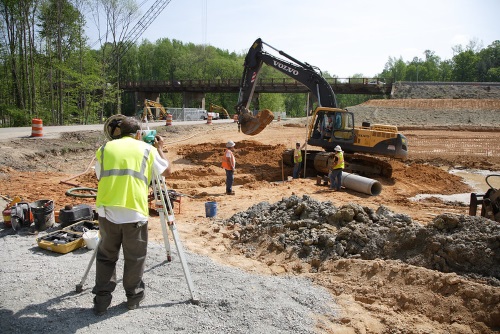The National Cooperative Highway Research Program (NCHRP) released a report in February 2021 highlighting several state agency efforts to incorporate Green Infrastructure (GI) solutions into transportation drainage and landscaping design.
The American Association of State Highway and Transportation Officials helped research and publish that report – entitled Landscape Design Practices for Roadside Water Management: Domestic Scan 16-02 – as part of the joint AASHTO and Federal Highway Administration’s NCHRP “Domestic Scan Program.” That program helps speed up the transfer of information and technology among transportation agencies.
This article is the first in a two-part series – focusing on the state of the practice in GI in several agencies, as well as policies in place and challenges found in the industry. The second article will focus on recommendations for the future of GI implementation state transportation agencies.
According to the FHWA, “green infrastructure” is defined as “strategically planned and managed networks of natural lands, working landscapes and other open spaces that conserve ecosystem values and functions and provide associated benefits to human populations.” It also applies to various water management approaches where transportation infrastructure is concerned, including technologies that “infiltrate, evapotranspire, capture, and reuse stormwater to maintain or restore natural hydrologies.”
[Above photo by the Virginia DOT]
The NCHRP’s new report — Landscape Design Practices for Roadside Water Management: Domestic Scan 16-02 – developed a more specific definition for GI. That definition included “roadside stormwater management, Low Impact Development or LID, hydro-modification, and watershed actions that conserve water, buffer climate change impacts, improve water quality, water supply, public heath, and restores and protects rivers, creeks and streams as a component of transportation development projects and operations.”
The team compiling the report found, however, that the practice of incorporating GI is inconsistent among state departments of transportation – employed only when required. Overall findings suggest GI is not yet a part of the state DOT stormwater management toolbox and is not routinely employed as a standard stormwater management method.
That team included:
- Jennifer Taira, senior landscape architect for the California Department of Transportation and chair of AASHTO’s NCHRP committee.
- Ken Graeve, erosion and stormwater management unit supervisor with the Minnesota Department of Transportation
- Charles Hebson, manager of the surface water resources division for the Maine Department of Transportation
- Garrett Jackson, a hydrologist with the Washington State Department of Transportation
- Laura Riggs, LRSP and SRTPP program manager for the Louisiana Department of Transportation
- Brian Smith, ecologist and biologist for the FHWA
- Lucy Joyce, former landscape architect supervisor with the Nevada Department of Transportation
That team further investigated how leading transportation agencies are applying principles and practices of GI for roadside water management and then planned to develop recommendations to help agencies look to the future of a higher level of implementation.
A central finding of this report is that, historically, managing the “peak flow” of water off roads to nearby waterways has been the traditional focus of transportation infrastructure design via techniques such as “gray infrastructure,” which includes culverts and pipes, to move the water offsite quickly. However, the report found that approach is sometimes neither the most efficient nor cost-effective in terms of managing that water flow. Newer GI techniques – such as water harvesting, landform grading, rain gardens, micro-catchment basins in arid climates, and large-watershed – are proving to be more efficient “green solutions.”

On top of that, many of the GI practices in use today resulted from various regulatory requirements for clean water/clean air imposed by the Environmental Protection Agency as well as state departments of environmental protection/quality. Yet the report discovered that many of those regulatory efforts – typically at the state level – often included barriers that hindered a state DOT’s ability to fully or successfully implement the switch to more efficient and low cost GI practices.
For example, the “gray” approaches to managing stormwater runoff from roads and highway can actually contribute to the problems of flooding and stormwater pollution in some cases.
To discern what GI practices work best, the report team sent out a survey to seven state DOTs (Arizona, Maryland, Michigan, Nevada, Oregon, Pennsylvania, and Washington) and five cities, counties, or regional agencies (Philadelphia, Pennsylvania; New York City, New York; Long Creek Watershed Management District, Maine; Southeast Michigan Council of Governments [SEMCOG], Michigan; and King County, Washington).

In addition to the survey responses, the team met directly with several of them during a series of three-day workshops.
The survey and workshop discussions resulted in a series of key GI implementation focal points:
- “Intensity of regulations really affects what gets implemented.”
- “Technology matters, especially geospatial data management.”
- “Training/education is important in implementing effective maintenance”
- “Watershed approach is key.”
- “Planning level of DOTs is important to coordinate stormwater needs and optimize opportunities.”
- “Maintenance is important; we could have an entire scan on maintenance of these solutions”
- “Standards, codes, policy, ordinances as important tools for driving/enabling green stormwater infrastructure”
While the survey answers and workshop discussions highlight “significant movement” toward more use of GI solutions in landscaping and storm water management, the funding, support, construction, and maintenance practice for GI remained inconsistent.
As a result, the report team outlined eight recommendations to promote GI practices among state DOTs in the future — recommendations detailed in part two of this series next week.

